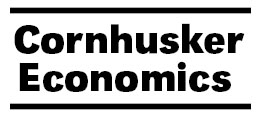Agricultural Economics, Department of

Cornhusker Economics
Date of this Version
10-23-2019
Document Type
Newsletter Issue
Citation
agecon.unl.edu/cornhuskereconomics
Abstract
When the 2018 Farm Bill was signed last December, producers could look ahead to implementation and the coming decision between enrollment under the Agricultural Risk Coverage (ARC) program or the Price Loss Coverage (PLC) program. While the ARC and PLC programs carried over from the 2014 Farm Bill with relatively modest changes, the substantial drop in market prices and outlook since 2014 pointed toward a widespread shift in enrollment away from ARC and toward PLC due to the increased relevance of the price safety net.
However, with this year’s extreme weather events, concerns over crop production, and hopes for improved trade prospects, there has been some recovery in commodity prices, at least as reflected in the October supply and demand reports from USDA. That could affect expected farm program supports or even eliminate them if higher prices were sustained through the marketing year. That in turn could affect producer preferences between the revenue-based support of ARC and the price-based support of PLC by the time the initial enrollment decision is due in March 2020.
Commodity Programs
The 2018 Farm Bill maintained the existing ARC program at both the county level (ARC-CO) and individual coverage level (ARC-IC) as well as the PLC program that were introduced in the 2014 Farm Bill. In 2014, producers faced a one-time election as to which program to use for the 2014 through 2018 crop years. The new farm bill made some improvements to the ARC program, including changes to the yield data and a trend-yield calculation that should improve the ARC guarantee. There were also modest changes to the PLC program, including a limited yield update and a formula to increase the reference price if market prices increase. However, the biggest feature of the new farm bill for ARC and PLC has to be a new enrollment decision, first in 2019 for 2019 and 2020, and then annually beginning in 2021.

